Report: Financial Sources & Investment Appraisal for Zylla Company
VerifiedAdded on 2020/10/23
|7
|1266
|320
Report
AI Summary
This report analyzes the financial strategies of Zylla Company, a ferries manufacturing company, focusing on short-term and long-term sources of finance and various investment appraisal techniques. The report explores short-term sources such as trade creditors, bill discounting, and factoring, emphasizing their role in fulfilling working capital requirements. Long-term sources, including owner's savings, bank loans, and issuing equity or debentures, are also examined in the context of business expansion. Furthermore, the report delves into investment appraisal techniques like Payback Period (PP), Net Present Value (NPV), Internal Rate of Return (IRR), and Accounting Rate of Return (ARR), providing formulas, calculations, and interpretations to evaluate the profitability and feasibility of potential investments. The conclusion highlights the importance of these financial tools in making informed decisions for business operations and expansion.

Report
Paraphrase This Document
Need a fresh take? Get an instant paraphrase of this document with our AI Paraphraser

Table of Contents
INTRODUCTION...........................................................................................................................1
MAIN BODY...................................................................................................................................1
1. Short term or Long term source of finance..............................................................................1
2. Investment Appraisal Techniques............................................................................................2
CONCLUSION................................................................................................................................4
INTRODUCTION...........................................................................................................................1
MAIN BODY...................................................................................................................................1
1. Short term or Long term source of finance..............................................................................1
2. Investment Appraisal Techniques............................................................................................2
CONCLUSION................................................................................................................................4
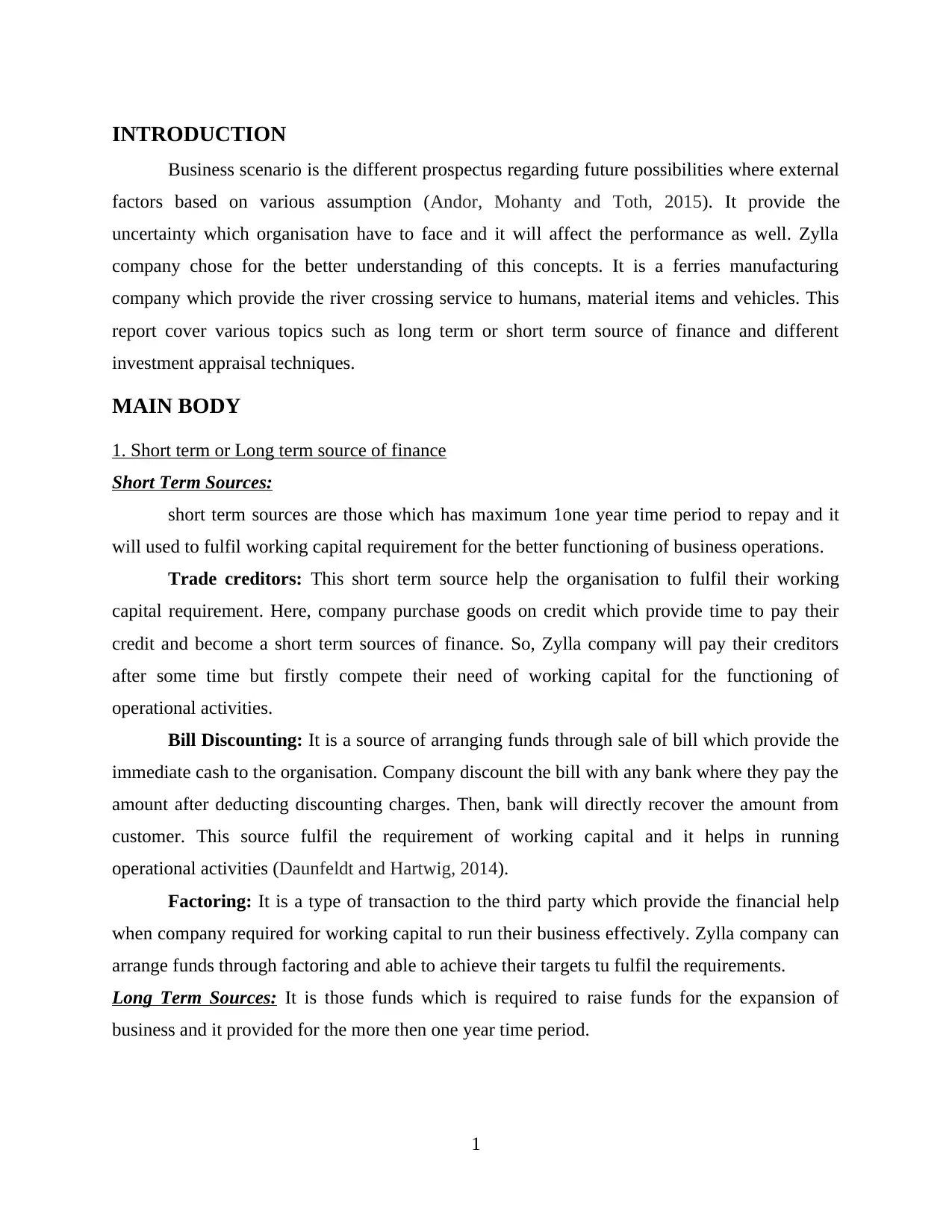
INTRODUCTION
Business scenario is the different prospectus regarding future possibilities where external
factors based on various assumption (Andor, Mohanty and Toth, 2015). It provide the
uncertainty which organisation have to face and it will affect the performance as well. Zylla
company chose for the better understanding of this concepts. It is a ferries manufacturing
company which provide the river crossing service to humans, material items and vehicles. This
report cover various topics such as long term or short term source of finance and different
investment appraisal techniques.
MAIN BODY
1. Short term or Long term source of finance
Short Term Sources:
short term sources are those which has maximum 1one year time period to repay and it
will used to fulfil working capital requirement for the better functioning of business operations.
Trade creditors: This short term source help the organisation to fulfil their working
capital requirement. Here, company purchase goods on credit which provide time to pay their
credit and become a short term sources of finance. So, Zylla company will pay their creditors
after some time but firstly compete their need of working capital for the functioning of
operational activities.
Bill Discounting: It is a source of arranging funds through sale of bill which provide the
immediate cash to the organisation. Company discount the bill with any bank where they pay the
amount after deducting discounting charges. Then, bank will directly recover the amount from
customer. This source fulfil the requirement of working capital and it helps in running
operational activities (Daunfeldt and Hartwig, 2014).
Factoring: It is a type of transaction to the third party which provide the financial help
when company required for working capital to run their business effectively. Zylla company can
arrange funds through factoring and able to achieve their targets tu fulfil the requirements.
Long Term Sources: It is those funds which is required to raise funds for the expansion of
business and it provided for the more then one year time period.
1
Business scenario is the different prospectus regarding future possibilities where external
factors based on various assumption (Andor, Mohanty and Toth, 2015). It provide the
uncertainty which organisation have to face and it will affect the performance as well. Zylla
company chose for the better understanding of this concepts. It is a ferries manufacturing
company which provide the river crossing service to humans, material items and vehicles. This
report cover various topics such as long term or short term source of finance and different
investment appraisal techniques.
MAIN BODY
1. Short term or Long term source of finance
Short Term Sources:
short term sources are those which has maximum 1one year time period to repay and it
will used to fulfil working capital requirement for the better functioning of business operations.
Trade creditors: This short term source help the organisation to fulfil their working
capital requirement. Here, company purchase goods on credit which provide time to pay their
credit and become a short term sources of finance. So, Zylla company will pay their creditors
after some time but firstly compete their need of working capital for the functioning of
operational activities.
Bill Discounting: It is a source of arranging funds through sale of bill which provide the
immediate cash to the organisation. Company discount the bill with any bank where they pay the
amount after deducting discounting charges. Then, bank will directly recover the amount from
customer. This source fulfil the requirement of working capital and it helps in running
operational activities (Daunfeldt and Hartwig, 2014).
Factoring: It is a type of transaction to the third party which provide the financial help
when company required for working capital to run their business effectively. Zylla company can
arrange funds through factoring and able to achieve their targets tu fulfil the requirements.
Long Term Sources: It is those funds which is required to raise funds for the expansion of
business and it provided for the more then one year time period.
1
⊘ This is a preview!⊘
Do you want full access?
Subscribe today to unlock all pages.

Trusted by 1+ million students worldwide
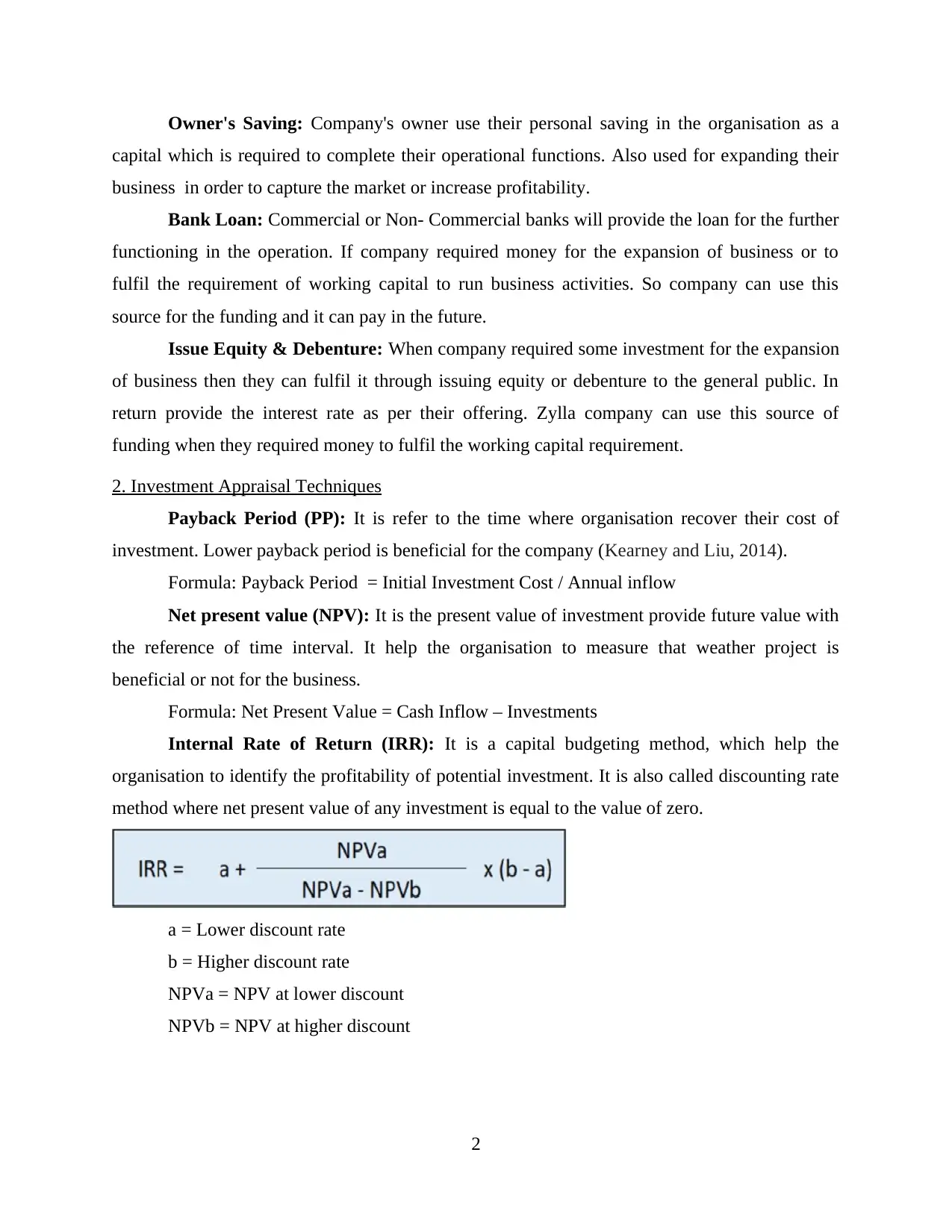
Owner's Saving: Company's owner use their personal saving in the organisation as a
capital which is required to complete their operational functions. Also used for expanding their
business in order to capture the market or increase profitability.
Bank Loan: Commercial or Non- Commercial banks will provide the loan for the further
functioning in the operation. If company required money for the expansion of business or to
fulfil the requirement of working capital to run business activities. So company can use this
source for the funding and it can pay in the future.
Issue Equity & Debenture: When company required some investment for the expansion
of business then they can fulfil it through issuing equity or debenture to the general public. In
return provide the interest rate as per their offering. Zylla company can use this source of
funding when they required money to fulfil the working capital requirement.
2. Investment Appraisal Techniques
Payback Period (PP): It is refer to the time where organisation recover their cost of
investment. Lower payback period is beneficial for the company (Kearney and Liu, 2014).
Formula: Payback Period = Initial Investment Cost / Annual inflow
Net present value (NPV): It is the present value of investment provide future value with
the reference of time interval. It help the organisation to measure that weather project is
beneficial or not for the business.
Formula: Net Present Value = Cash Inflow – Investments
Internal Rate of Return (IRR): It is a capital budgeting method, which help the
organisation to identify the profitability of potential investment. It is also called discounting rate
method where net present value of any investment is equal to the value of zero.
a = Lower discount rate
b = Higher discount rate
NPVa = NPV at lower discount
NPVb = NPV at higher discount
2
capital which is required to complete their operational functions. Also used for expanding their
business in order to capture the market or increase profitability.
Bank Loan: Commercial or Non- Commercial banks will provide the loan for the further
functioning in the operation. If company required money for the expansion of business or to
fulfil the requirement of working capital to run business activities. So company can use this
source for the funding and it can pay in the future.
Issue Equity & Debenture: When company required some investment for the expansion
of business then they can fulfil it through issuing equity or debenture to the general public. In
return provide the interest rate as per their offering. Zylla company can use this source of
funding when they required money to fulfil the working capital requirement.
2. Investment Appraisal Techniques
Payback Period (PP): It is refer to the time where organisation recover their cost of
investment. Lower payback period is beneficial for the company (Kearney and Liu, 2014).
Formula: Payback Period = Initial Investment Cost / Annual inflow
Net present value (NPV): It is the present value of investment provide future value with
the reference of time interval. It help the organisation to measure that weather project is
beneficial or not for the business.
Formula: Net Present Value = Cash Inflow – Investments
Internal Rate of Return (IRR): It is a capital budgeting method, which help the
organisation to identify the profitability of potential investment. It is also called discounting rate
method where net present value of any investment is equal to the value of zero.
a = Lower discount rate
b = Higher discount rate
NPVa = NPV at lower discount
NPVb = NPV at higher discount
2
Paraphrase This Document
Need a fresh take? Get an instant paraphrase of this document with our AI Paraphraser
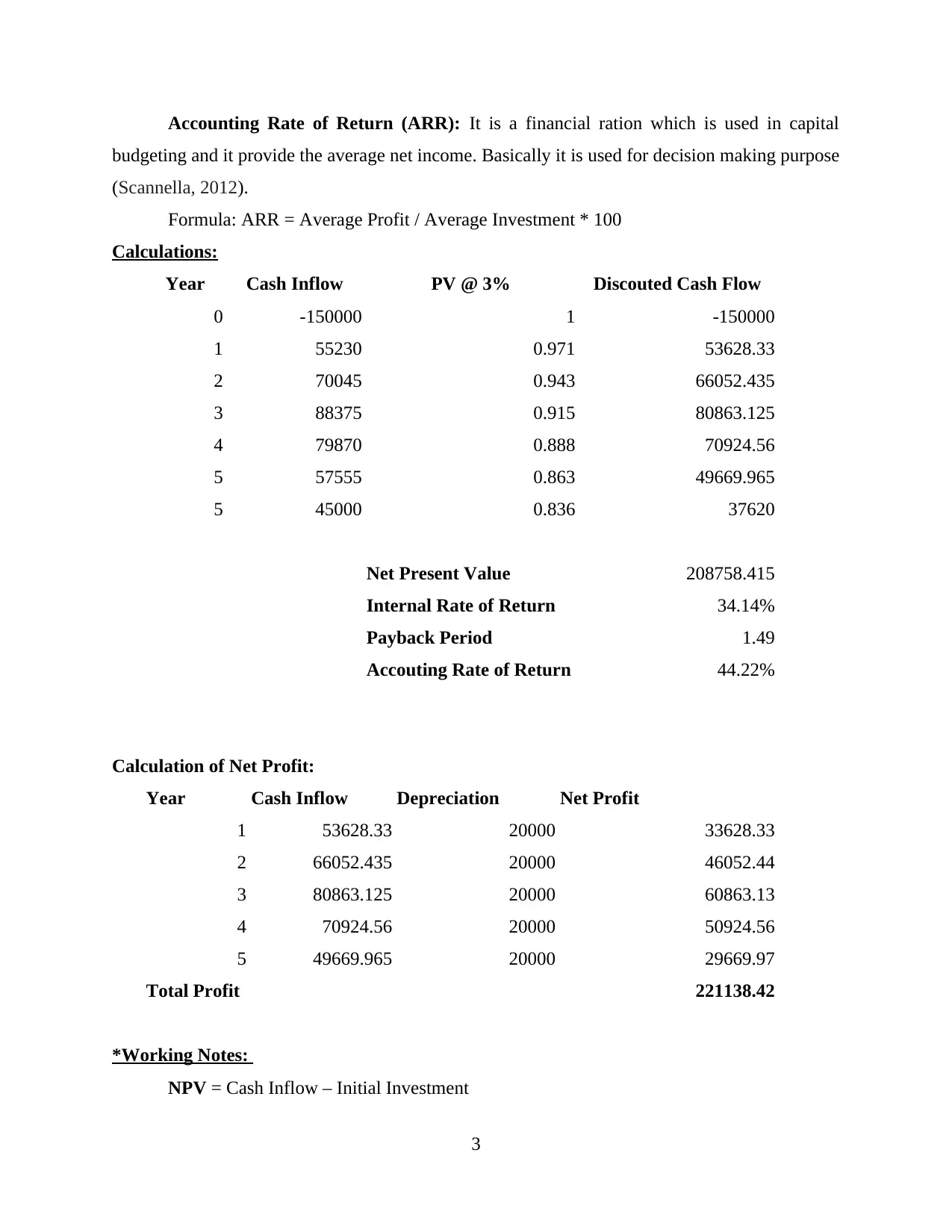
Accounting Rate of Return (ARR): It is a financial ration which is used in capital
budgeting and it provide the average net income. Basically it is used for decision making purpose
(Scannella, 2012).
Formula: ARR = Average Profit / Average Investment * 100
Calculations:
Year Cash Inflow PV @ 3% Discouted Cash Flow
0 -150000 1 -150000
1 55230 0.971 53628.33
2 70045 0.943 66052.435
3 88375 0.915 80863.125
4 79870 0.888 70924.56
5 57555 0.863 49669.965
5 45000 0.836 37620
Net Present Value 208758.415
Internal Rate of Return 34.14%
Payback Period 1.49
Accouting Rate of Return 44.22%
Calculation of Net Profit:
Year Cash Inflow Depreciation Net Profit
1 53628.33 20000 33628.33
2 66052.435 20000 46052.44
3 80863.125 20000 60863.13
4 70924.56 20000 50924.56
5 49669.965 20000 29669.97
Total Profit 221138.42
*Working Notes:
NPV = Cash Inflow – Initial Investment
3
budgeting and it provide the average net income. Basically it is used for decision making purpose
(Scannella, 2012).
Formula: ARR = Average Profit / Average Investment * 100
Calculations:
Year Cash Inflow PV @ 3% Discouted Cash Flow
0 -150000 1 -150000
1 55230 0.971 53628.33
2 70045 0.943 66052.435
3 88375 0.915 80863.125
4 79870 0.888 70924.56
5 57555 0.863 49669.965
5 45000 0.836 37620
Net Present Value 208758.415
Internal Rate of Return 34.14%
Payback Period 1.49
Accouting Rate of Return 44.22%
Calculation of Net Profit:
Year Cash Inflow Depreciation Net Profit
1 53628.33 20000 33628.33
2 66052.435 20000 46052.44
3 80863.125 20000 60863.13
4 70924.56 20000 50924.56
5 49669.965 20000 29669.97
Total Profit 221138.42
*Working Notes:
NPV = Cash Inflow – Initial Investment
3
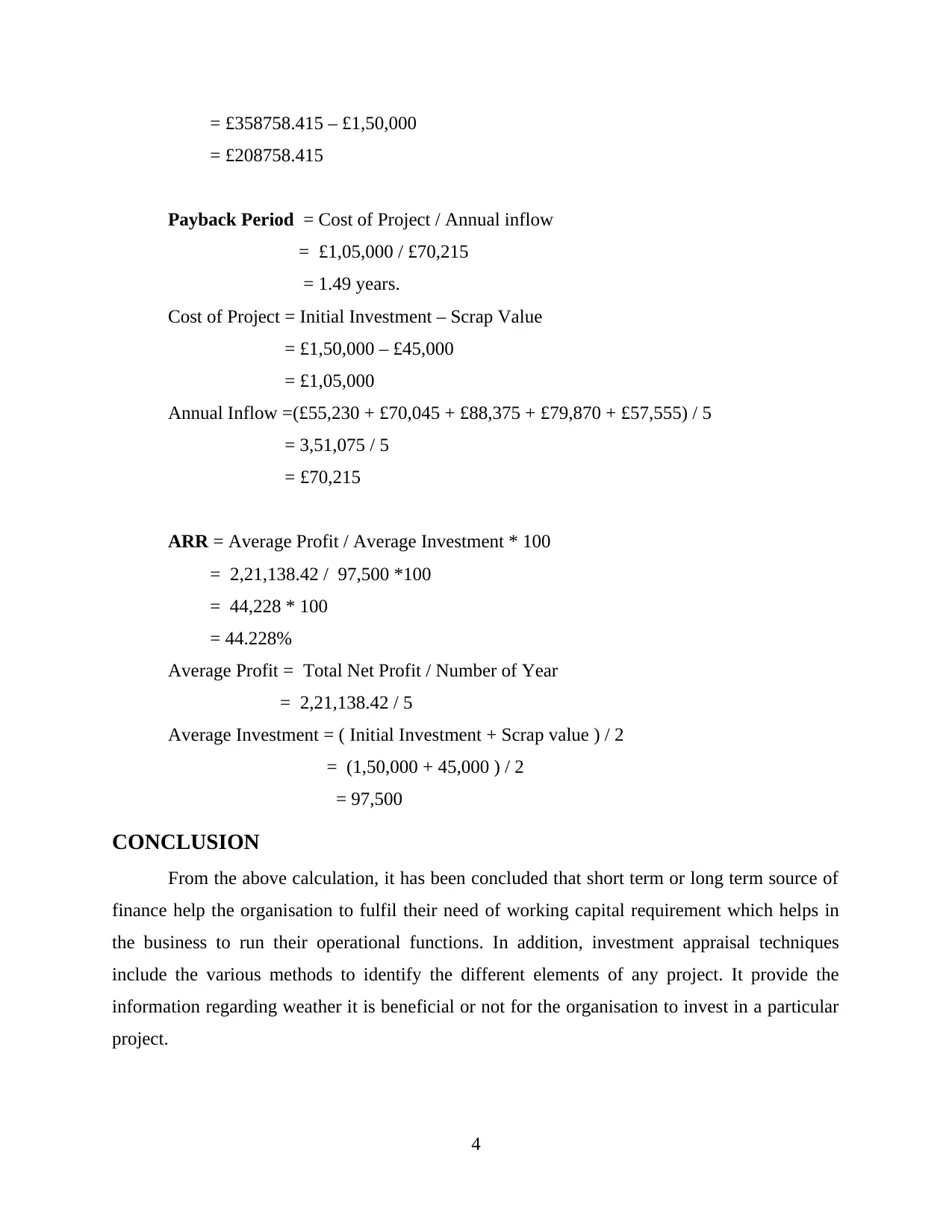
= £358758.415 – £1,50,000
= £208758.415
Payback Period = Cost of Project / Annual inflow
= £1,05,000 / £70,215
= 1.49 years.
Cost of Project = Initial Investment – Scrap Value
= £1,50,000 – £45,000
= £1,05,000
Annual Inflow =(£55,230 + £70,045 + £88,375 + £79,870 + £57,555) / 5
= 3,51,075 / 5
= £70,215
ARR = Average Profit / Average Investment * 100
= 2,21,138.42 / 97,500 *100
= 44,228 * 100
= 44.228%
Average Profit = Total Net Profit / Number of Year
= 2,21,138.42 / 5
Average Investment = ( Initial Investment + Scrap value ) / 2
= (1,50,000 + 45,000 ) / 2
= 97,500
CONCLUSION
From the above calculation, it has been concluded that short term or long term source of
finance help the organisation to fulfil their need of working capital requirement which helps in
the business to run their operational functions. In addition, investment appraisal techniques
include the various methods to identify the different elements of any project. It provide the
information regarding weather it is beneficial or not for the organisation to invest in a particular
project.
4
= £208758.415
Payback Period = Cost of Project / Annual inflow
= £1,05,000 / £70,215
= 1.49 years.
Cost of Project = Initial Investment – Scrap Value
= £1,50,000 – £45,000
= £1,05,000
Annual Inflow =(£55,230 + £70,045 + £88,375 + £79,870 + £57,555) / 5
= 3,51,075 / 5
= £70,215
ARR = Average Profit / Average Investment * 100
= 2,21,138.42 / 97,500 *100
= 44,228 * 100
= 44.228%
Average Profit = Total Net Profit / Number of Year
= 2,21,138.42 / 5
Average Investment = ( Initial Investment + Scrap value ) / 2
= (1,50,000 + 45,000 ) / 2
= 97,500
CONCLUSION
From the above calculation, it has been concluded that short term or long term source of
finance help the organisation to fulfil their need of working capital requirement which helps in
the business to run their operational functions. In addition, investment appraisal techniques
include the various methods to identify the different elements of any project. It provide the
information regarding weather it is beneficial or not for the organisation to invest in a particular
project.
4
⊘ This is a preview!⊘
Do you want full access?
Subscribe today to unlock all pages.

Trusted by 1+ million students worldwide
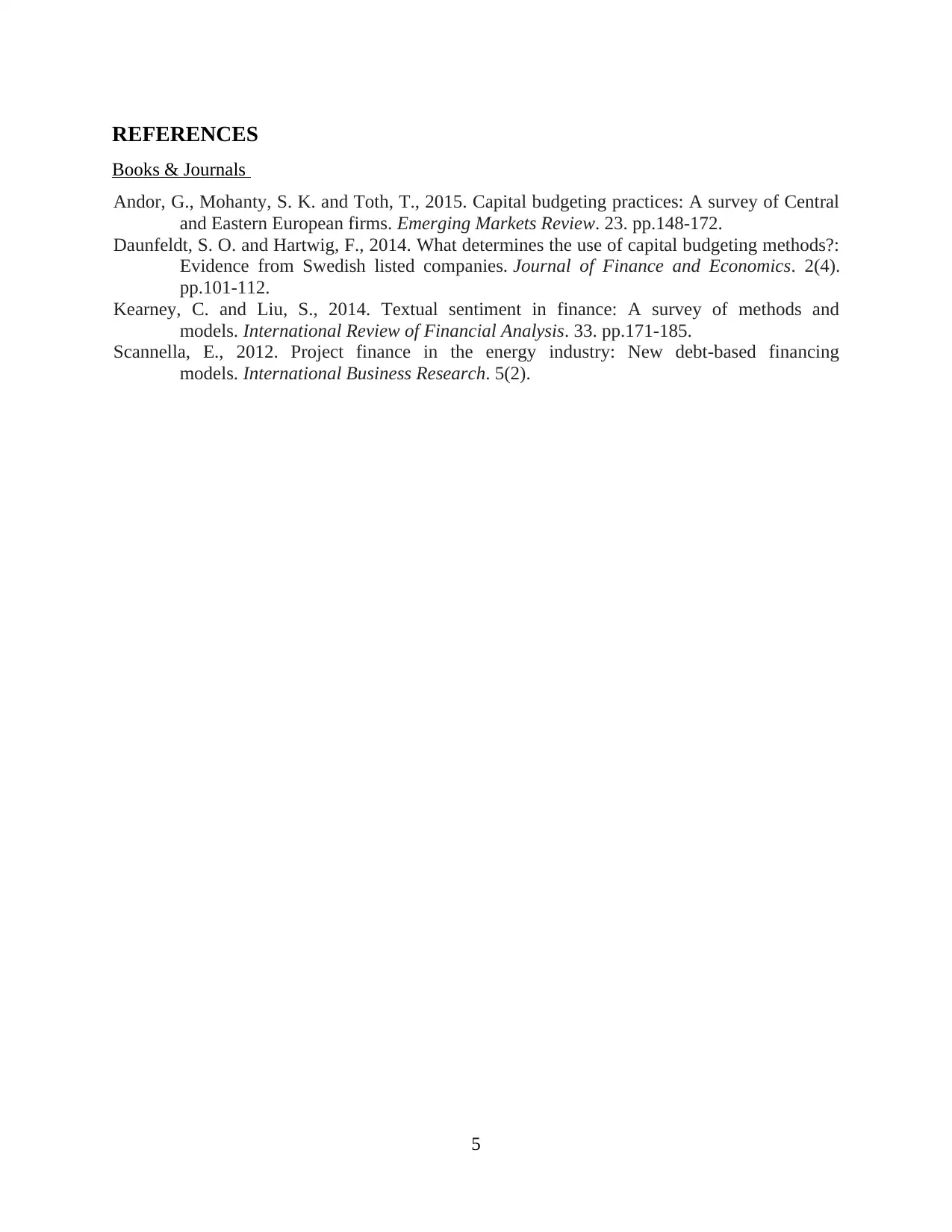
REFERENCES
Books & Journals
Andor, G., Mohanty, S. K. and Toth, T., 2015. Capital budgeting practices: A survey of Central
and Eastern European firms. Emerging Markets Review. 23. pp.148-172.
Daunfeldt, S. O. and Hartwig, F., 2014. What determines the use of capital budgeting methods?:
Evidence from Swedish listed companies. Journal of Finance and Economics. 2(4).
pp.101-112.
Kearney, C. and Liu, S., 2014. Textual sentiment in finance: A survey of methods and
models. International Review of Financial Analysis. 33. pp.171-185.
Scannella, E., 2012. Project finance in the energy industry: New debt-based financing
models. International Business Research. 5(2).
5
Books & Journals
Andor, G., Mohanty, S. K. and Toth, T., 2015. Capital budgeting practices: A survey of Central
and Eastern European firms. Emerging Markets Review. 23. pp.148-172.
Daunfeldt, S. O. and Hartwig, F., 2014. What determines the use of capital budgeting methods?:
Evidence from Swedish listed companies. Journal of Finance and Economics. 2(4).
pp.101-112.
Kearney, C. and Liu, S., 2014. Textual sentiment in finance: A survey of methods and
models. International Review of Financial Analysis. 33. pp.171-185.
Scannella, E., 2012. Project finance in the energy industry: New debt-based financing
models. International Business Research. 5(2).
5
1 out of 7
Related Documents
Your All-in-One AI-Powered Toolkit for Academic Success.
+13062052269
info@desklib.com
Available 24*7 on WhatsApp / Email
![[object Object]](/_next/static/media/star-bottom.7253800d.svg)
Unlock your academic potential
Copyright © 2020–2025 A2Z Services. All Rights Reserved. Developed and managed by ZUCOL.





